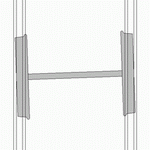Sinus run
The sine run , also called wave run , occurs in wheel-rail systems with conically profiled , i.e. rigidly coupled wheels that taper towards the outside . The purpose of the conicity is the self-centering of the wheelset in a straight track without using the flanges .
With small amplitudes, this movement is sinusoidal and has a constant wavelength, i.e. a frequency that increases with the driving speed. It is fanned at high speed by dynamic forces ( hunting oscillation ) up to the zigzag run with the flanges hitting the rails, so that damping measures have to be taken to avoid excessive wear and tear and loss of comfort due to vibrations .
With the Talgo , the two wheels of an axle are not coupled with each other, so this self-centering principle cannot be used.
Sinusoidal taxiway
In the case of a wheel set with a conical wheel profile that is off-center on two parallel rails, the radii of the two wheels at the points of contact with the rails are different. Since the two wheels are rigidly connected via the wheelset shaft and rotate at the same speed, the wheel with the larger radius at the point of contact takes a longer way forward than the wheel with the smaller radius. Therefore, a wheel set that is too far to the right steers to the left and vice versa. This results in a rolling motion that can be represented in a non-linear differential equation . In the limiting case of small amplitudes, i.e. with linearization, the solution is a sinusoid . The formula was published by Johannes Klingel in 1883. If there are no external stimuli due to curves or inaccuracies in the track laying, this oscillation should be dampened and decay.
In reality, the profiles are not exactly conical due to wear or are created as a wear profile in order to avoid a major change in the running behavior due to wear of the wheel and rail profile. In connection with the finite curvature of the rail profile neglected above, this leads to a non-linear dependence of the rolling radius on the lateral offset. If the contact points do not jump when the offset changes, this dependency can be approximated linearly for small deflections, see Equivalent Conicity , so that the above derivation remains valid. In the case of larger deflections, the non-linear increase in the rolling radius difference when approaching the wheel flange and the resulting vertical forces lead to the wheelset being forced to guide the track, even with unstable behavior.
Dynamic stability
The friction between wheel and rail, especially when two wheel sets are rigidly coupled in a bogie , dampens the vibration and stabilizes smooth running, while the excitation of the vibration increases with increasing speed. If the damping predominates, a wheelset that has got into an eccentric position due to an error in the track position or a curve returns to the central position after a few periods (damped behavior). If the excitation predominates, the amplitude increases until it is limited by increased non-linear forces on the wheel flanges. The high restoring forces at high speed disturb the passengers through vibrations and noise and strain the vehicle and the track superstructure and must be structurally avoided.
A pair of wheelsets in a bogie can run undisturbed up to 180 km / h; For higher speeds, the wheel profile can be chosen to be flatter (see equivalent conicity ) and the yaw movement of the bogie against the car body can be additionally dampened (e.g. rotary damper on bogie MD 36 or hard manganese plates on bogie MD 522). By appropriate design of the profiles, the rigidity within the bogie and the rotary damping, stable behavior at very high speeds can be achieved. Examples of this are the InterCityExperimental on the Munich-Freimann roller test bench with 500 km / h (1982) or on the open road with 407 km / h (1988) and the French TGV with a record speed of 574 km / h (2007). The MD 52-530 bogie from Waggon Union was selected for the German Series 1 ICE , based on the test results and the manufacturing costs .
Effects in practice
An exactly sinusoidal run occurs only in the simplified model; the actual path is also influenced by the fact that a normal wheelset usually does not have an exactly conical wheel profile and that the rail profile shape optimized for the taper and flange system does not run exactly at all points, as well as unregulated forces from the bogie or the Car body are initiated. Nevertheless, the running of wheelsets can be dampened so precisely that only wobbling movements in the millimeter range occur. This results in better running behavior and less wear than with wheelsets with a cylindrical wheel profile.
The maximum permissible speed of conventional rail vehicles is largely determined by the precise coordination of wheel and rail profiles and the guarantee of constant monitoring and rectification.
In the case of tracks with many tight radii, the advantages of a conical wheel profile with a sinusoidal course hardly come into play. The settling of a stable sine wave requires a certain undisturbed path length, which is usually not the case with light rail systems.
literature
- Klaus Knothe, Sebastian Stichel: Rail Vehicle Dynamics , 2003, ISBN 3540434291
- Rainer Kratochwille: For the benefit of switchable roll dampers ... , dissertation 2004
Individual evidence
- ↑ Jörn Pachl: Systemtechnik des Eisenbahnverkehr , Springer Vieweg, 2018, page 24
- ^ Peter Meinke, A. Mielcarek: Design and Evaluation of Trucks for High-Speed Wheel / Rail Application . Ed .: International Center for Mechanical Sciences. tape 274 . Springer, Vienna 1982, p. 281-331 (English).
- ↑ Peter Meinke, Lutz Mauer: Running bogie for the high-speed range . In: Railway technical review, running technology and drives of rail vehicles . tape 37 , no. 12 , 1988, pp. 791-798 .

